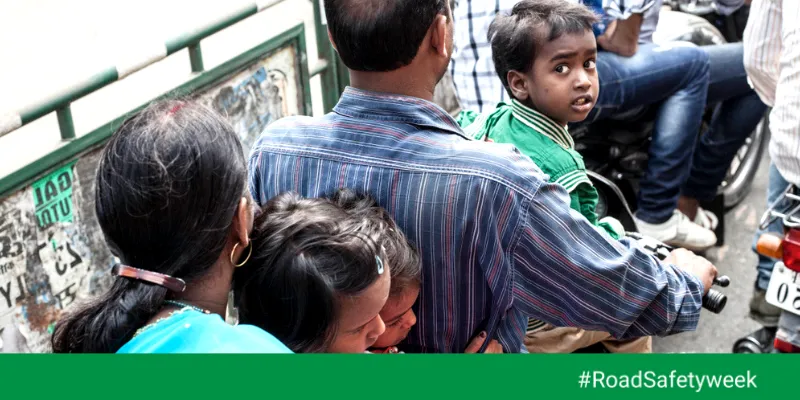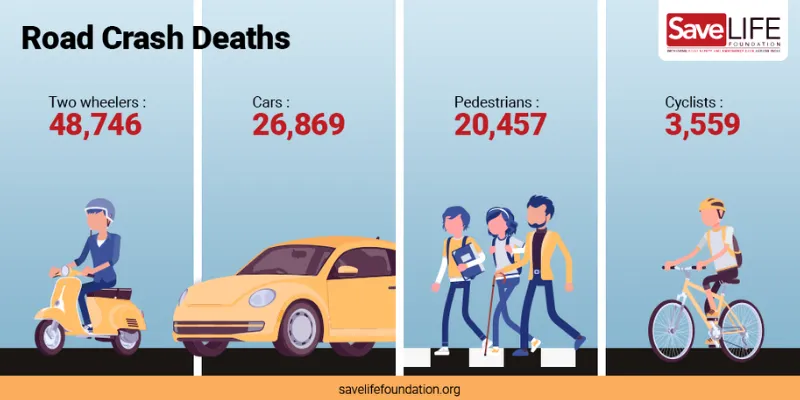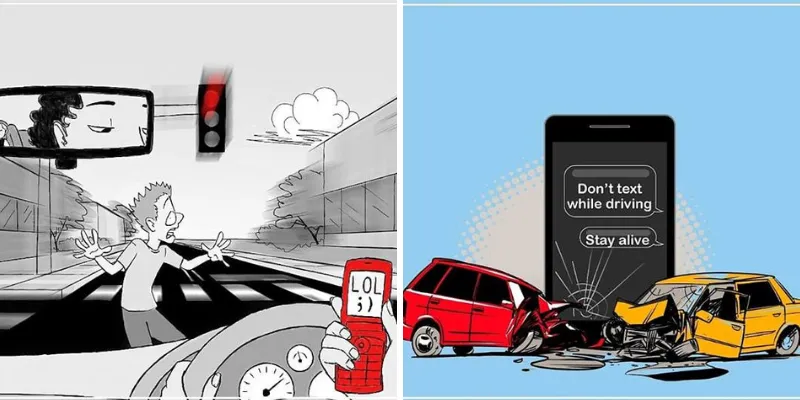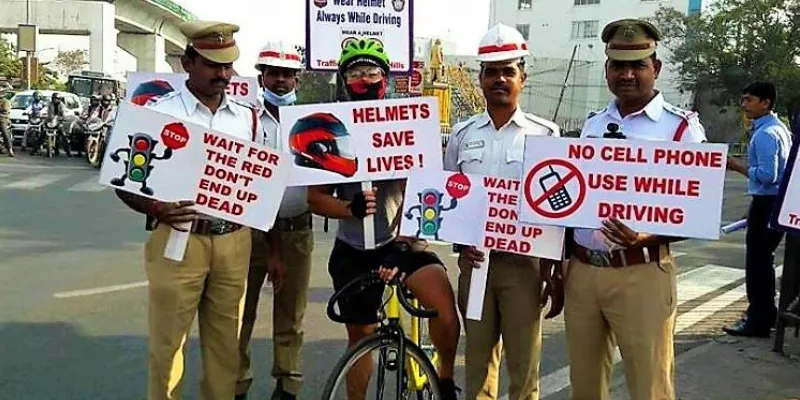What is India doing to put the brakes on the alarming number of roads accidents reported each year?
Road safety campaigns have not been able to bring about a change in behaviour and reduce the number of deaths and injuries suffered due to road accidents in India, which is the highest in the world in a year. So what needs to be done?

India is plagued by an alarming number of road accidents every year. So much so that it tops the global list, with five lakh accidents clocked every year.
Nitin Gadkari, Union Minister for Road, Transport and Highways, on the inauguration of the Road Safety Week rally at New Delhi on February 4, noted that his ministry is taking steps to address these scary statistics. The country had lost 1,47,913 people to road crashes in 2017, of which 48,764 were on two-wheelers, 26,869 were car crash victims, 20,457 were pedestrians deaths, and 3,559 were cyclists. This roughly amounts to an average of over 400 deaths every day on Indian roads.
“The Ministry of Road Transport and Highways has taken earnest steps for reducing the number of road accidents that include rectification of accident black spots, improved road engineering, training of drivers and awareness generation. Some positive, though small, results have been seen in the past two years, with some reduction in the number of accidents,” Gadkari said, admitting that a lot more needs to be done.

Over the past five years, the government has taken several measures to prevent crashes and fatalities from road accidents. These include a National Road Safety Policy, which outlines various policy measures such as promoting awareness, establishing road safety information database, encouraging safer road infrastructure and applying intelligent transport, and enforcement of safety laws. The government has also constituted the National Road Safety Council as the apex body to take policy decisions in matters of road safety. Further, it has conducted road safety audits of selected stretches of national highways.
The government approach
The Central government has also launched multiple initiatives to generate awareness and sensitise people about safe road usage. “Our vision is to make the transport on roads efficient, safe and sustainable, to reduce the accidents on roads by half,” says Mansukh L Mandaviya, Minister of State for Road, Transport and Highways.
Also read: Thanks to this NGO, you can help road accident victims without facing legal hassles
As part of this year’s road safety campaign by the Ministry of Road Transport and Highways, a dashboard for road accident data, through which people can access related data and other information both state-wise and the national averages, has been introduced. Further, the ministry has released a set of comic books on road safety, produced by Uber and Amar Chitra Katha, called Swachha Safar and Surakshit Yatra, with an aim to create awareness among children in an informal format that they can relate to. It has also launched the third edition of iSAFE, a nine-month-long championship on road safety issues for schools and colleges across India to use the students’ knowledge in their respective discipline, to bridge the gaps present in road safety.

The government maintains that these efforts have helped to reduce the number of fatal accidents. A total of 1,34,796 fatal accidents were reported in 2017, which is 0.9 percent lower than the 2016 figure of 1,36,071.
“In most of the cases crashes occur either due to carelessness or due to lack of road safety awareness of the road user. Hence, road safety education is as essential as any other basic skills of survival,” Mandaviya adds.
Also read: Safety first – how these startups are ensuring you reach home safe
To inform the common man of the rules and regulations for road safety, the ministry, along with the Indian Road Safety Campaign, an IIT Delhi student initiative, began a social media campaign with videos. Further, to help cut down road accidents by redressing improper road infrastructure, the campaign, which was started in 2016, offers a two-month paid "policy internship" for undergraduate students, through which they can learn to identify and fix unsafe roads across the country.

In response to badly designed roads, the government initiated the Bharatmala Pariyojana scheme in 2017 to bolster the efficiency of freight and passenger movement across the country.
Sanjeev Kumar, Chief Engineer, Standards and Roads Zone of Ministry of Road Transport and Highways, said,
“The objective of Bharatmala is to bridge infrastructural gaps by laying service roads and expressways, and connecting corridors to facilitate smooth movement of vehicles. A sum of Rs 5.6 lakh crore has been allotted for the same."
Also read: Road to recovery: What needs to be done to cut down on road accidents and ensure a safer India?
The long-pending Bill for road safety
Cognisant of the pressing need to incorporate a robust road safety law that lays the framework for safer, faster, cost-effective and more inclusive movement of passengers and freight in India, the ministry proposed to amend the Motor Vehicles (Amendment) Bill. It was passed by the Lok Sabha in April 2017, and sent to the Rajya Sabha, which referred it to a select committee in August 2017.
“This law (Motor Vehicles (Amendment) Bill) rectifies the 30-year-old Motor Vehicles Act, which governs road safety in India, and has failed to protect people on roads. The MVA Bill corrects a lot of the systemic issues by providing for the protection of children, rationalising penalties, a uniform driver licensing system, fixing liability for road contractors for faulty roads, introducing adult accountability for juvenile driving among other progressive provisions,” says Piyush Tewari, Founder of Savelife Foundation, an independent, non-profit, and public charitable trust that is working to improve road safety and emergency medical care across India.
The Bill will mark the first step to have a National Road Safety Board in India, which will oversee the workings of even taxi aggregators like Ola and Uber, issue third party insurance, and lead to computerisation of licensing authorities, thereby ushering in transparency in the system.

Also read: How the government and citizen groups are tackling badly designed roads in India
Multi-pronged approach
Apart from legal reforms and a long-term policy vision for road safety in India, the government, industry, and non-governmental institutions must focus on capacity building, including the application of technology to take on the problem at scale.
“The key reasons for such a high number of road crash fatalities in India are bad road user behaviour, flawed road design and engineering, weak enforcement of traffic laws, and lack of rapid trauma care,” Piyush explains.
Road safety is an issue that requires a multi-pronged solution. The problem gets exacerbated when all the factors contributing to mishaps overlap and lead to a systemic failure to provide safe mobility. Multiple startups are joining the government in its endeavour to ensure road safety using technology. They are diving deep into different factors that cause road accidents to come up with solutions for road safety.
A couple of simple interventions stand out. To avoid phone calls and texting while driving, a person can now use the Kruz app to send a message to the other person. Using motion sensors to detect when a user is driving, the app locks the phone screen and also handles calls and messages through an in-built chatbot, which interacts with the person on the other end, and informs them that the user is driving.
Further, to avoid accidents because of potholes and road humps, users can opt to use the Raksha SafeDrive device, which is attached with Velcro to the car, and alerts drivers about road humps, bad roads and on crossing speed limits.
Here’s hoping all the initiatives and announcements made during the Road Safety Week translate to sustained awareness and innovations in ensuring a lesser number of accidents throughout 2019.
This article was a part of the Road Safety Week series, where SocialStory discussed the multiple interventions required to make the Indian roads safer for the citizens.







